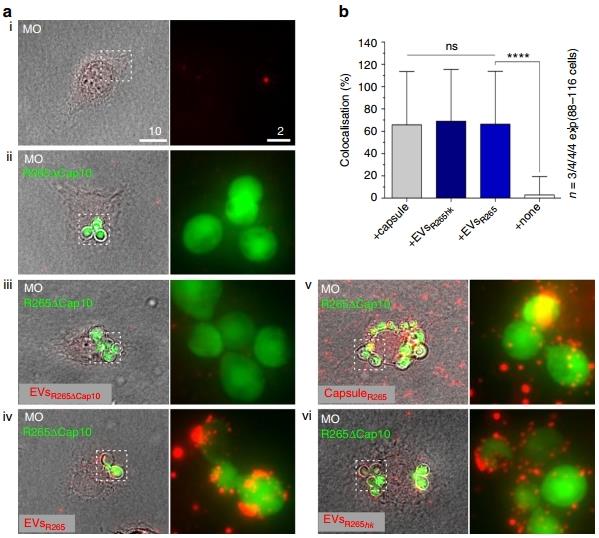Cryptococcus gattii-derived Exosome Research and Application
Cryptococcus gattii, a fungal pathogen capable of triggering diseases in immunocompetent populations, poses a significant threat with its potential pathogenicity, leading to severe pulmonary diseases and even fatal consequences. A profound insight into its pathogenic mechanisms is particularly crucial. Recent research findings reveal that the micro-molecular components contained within Cryptococcus gattii-derived exosomes might hold immunomodulatory potential. Thoroughly understanding the roles and mechanisms of these micro-molecules not only broadens our knowledge of the pathogenic characteristics of Cryptococcus gattii but may also pave the way for the development of novel treatment approaches and the reinforcement of the host defense system. As a global leader in exosome technology providers, Creative Biolabs exhibits a strong interest and proactive attitude in supporting such exosome research.
Cryptococcus gattii Overview
Geographical Distribution: Cryptococcus gattii is globally distributed, especially in temperate and tropical regions. It has caused several outbreaks in the Pacific Northwest region of North America and Vancouver Island and is endemic in South American countries like Brazil.
Differences from Cryptococcus neoformans: Although Cryptococcus gattii is genetically very close to Cryptococcus neoformans, they have significant differences in pathogenic mechanisms and host responses. Cryptococcus gattii tends to cause severe pulmonary diseases and is less likely to spread to other organs; whereas Cryptococcus neoformans easily disseminates to the central nervous system, causing meningitis. Moreover, Cryptococcus neoformans primarily infects immunosuppressed hosts, while Cryptococcus gattii can induce diseases in immunocompetent individuals.
Pathogenic Mechanisms: The pathogenic mechanisms of Cryptococcus gattii are complex, primarily affecting the host through several pathways:
-
Immune Recognition and Evasion: Cryptococcus gattii enters the host's lungs through the respiratory tract, where its pathogen-associated molecular patterns (PAMPs) are recognized by the lung phagocytic cell pattern recognition receptors (PRRs), triggering immune killing actions.
-
Virulence Factors: Cryptococcus gattii has various virulence factors, including polysaccharide capsules, chitin, and melanin, as well as enzymes like phospholipase, urease, laccase, and the ability to grow at 37°C. These virulence factors help the fungus survive and proliferate within the host, evade the immune system's killing, or enhance its growth in phagocytic cells.
-
Sexual Reproduction and Transmission: Basidiospores produced by sexual reproduction of Cryptococcus are highly infectious. They can easily become aerosolized, serving as effective transmission vectors.
-
Exosomes: Cryptococcus gattii can produce exosomes, structures that play a crucial role in the physiological and pathological processes of the fungus. The various components carried by these exosomes may be toxic to host cells or modulate host immune responses.
Focusing on Cryptococcus gattii-derived Exosomes
Cryptococcus gattii-derived exosomes play a key role in the interaction between the pathogen and host, pathogenicity, and immunomodulation:
1. Transport of Bioactive Molecules and Immune Modulation:
The exosomes of Cryptococcus gattii contain bioactive small molecules capable of modulating host immune responses. Notably, a tripeptide (Ile-Pro-Ile) has shown protective effects in improving survival rates in lethal infection models.1
2. Long-Distance Communication:
Non-outbreak strains within the host would normally be eliminated. However, exosomes released by pathogenic strains are taken up by host macrophages and transported to the phagosome, thereby triggering rapid intracellular growth of non-outbreak strains.2
3. Participation in Cryptococcus gattii's Own Activities:
Cryptococcus gattii-derived exosomes are involved in crucial biological processes, such as the export of polysaccharides and the construction of the glial layer.3
 Fig.1 Extracellular vesicles added to macrophages rapidly colocalise with the cryptococcal phagosome.1,2
Fig.1 Extracellular vesicles added to macrophages rapidly colocalise with the cryptococcal phagosome.1,2
Cryptococcus gattii-derived exosomes exhibit significant biomedical potential, particularly in terms of pathogenicity regulation, immune intervention, and novel therapeutic strategies. They hold great value in promoting communication between pathogens, modulating host immune responses, and potential vaccine development. Further research into these extracellular vesicles may reveal new antifungal treatment methods and mechanisms to enhance host disease resistance. Creative Biolabs, with its professional microbial-derived exosome platform, is committed to providing comprehensive support to clients. We welcome you to contact us to explore new horizons in scientific research.
Microorganism-derived Exosome Isolation and Identification
In Vitro Functional Discovery of Microorganism-derived Exosomes
In Vivo Functional Discovery of Microorganism-derived Exosomes
References
-
Bielska, E.; et al. Pathogen-derived extracellular vesicles mediate virulence in the fatal human pathogen Cryptococcus gattii. Nature Communications. 2018, 9(1):1556.
-
under Open Access license CC BY 4.0, without modification.
For Research Use Only. Cannot be used by patients.
Related Services:

 Fig.1 Extracellular vesicles added to macrophages rapidly colocalise with the cryptococcal phagosome.1,2
Fig.1 Extracellular vesicles added to macrophages rapidly colocalise with the cryptococcal phagosome.1,2









